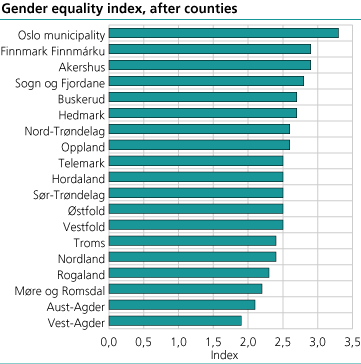Content
Published:
This is an archived release.
Hammerfest and Sør-Varanger on top
The gender equality index for 2002 indicates that Hammerfest and Sør-Varanger are the most gender-equal municipalities in the country. Among counties Oslo, Finnmark and Akershus are on top, whereas Agder-counties and Møre and Romsdal are at bottom.1
This is the third year Hammerfest is on top. This year Hammerfest has to share the first place with Sør-Varanger, whereof both has a index of 3.8 On a shared third we find Leikanger and Nesna with a score of 3,7. Vanylven is at bottom with a score of 1.2, second from the bottom are municipalities Selje, Herøy and Haram are at the bottom with an index of 1.3.
The national average is on 2.5. Among the larges cities are above the average. Oslo is the best of these, with a score of 3.3, followed by Stavanger (3.1) and Trondheim (2.9), and Drammen (2.8), and at least Bergen and Kristiansand and Bergen (2.6).
Few changes
Last year Rollag was on a shared second with Sør-Varanger. Sør-Varanger has this year, as last, 3.8 points and advance to a shared first. Rollag, on the other hand, has this year 3.4 points and approach to seventeenth. Among counties Oslo is on top with a score of 3.3, followed by Stavanger -3.1 and Trondheim -2.9, Drammen -2.8, and and at least Kristiansand -2.6. Bergen has an index of 2.3, and with that Bergen is below the average for Norway.
The difference between the most gender-equal to the worst gender-equal counties is relatively small. 4 are the highest possible score and 1 is the lowest possible score. Figure 1 illustrates counties after ascending score.
Many ways to depict gender equality
Equality between women and men may be depicted in many different ways, and with the aid of many kinds of statistics. An index is a composite measurement , a way to simplify or compress data. In the gender equality index we try to combine various - direct and indirect - measurements of gender equality that show the extent to which women and men participate in politics, education and working life in an individual municipality. The measurements or indicators making up the index are:
* Kindergarten coverage for children aged 1-5 (2001)
* The number of women per 100 men aged 20-39 (2001)
* Womens and mens education levels (2000)
* Women and men in labor force (2001)
* Womens and mens incomes (2000)
* Percentage of female municipal council members (1999)
This combination of indicators is, of course, only one of several possible ways to show the gender equality situation in Norwegian municipalities. The index takes in the relevant statistics available, and, indeed, the chief measurable factors are included.
The indicator "Percentage of women per 100 men" is included as a sort of indirect measure. Municipalities with few opportunities for education and a non-diversified (male-dominated) industrial structure usually experience out-migration of young, adult women. A low percentage of women thus indicate that the basis for gender equality in the municipality is week.
| 1 | New article was released 6 March 2003. |
Tables:
- Table 1 Gender equality index for Norwegian municipalities, rank. 2002 (New table was released 6 March 2003)
- Table 2 Gender equality index for Norwegian municipalities, after counties. 2002 (New table was released 6 March 2003)
- Table 3 Gender equality index for Norwegian municipalities, rank after counties. 2002 (New table was released 6 March 2003)
Additional information
The indicators of gender equality in municipalities has been published every year since 2008. The indicators are based on available statistics from registers, and measure gender equality in all municipalities and counties, as well as average for the whole country.

